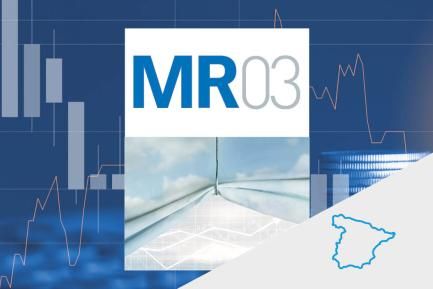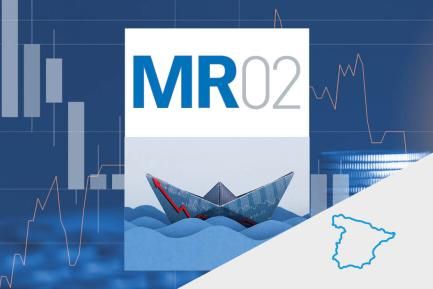
The vaccines curb the impact of the Delta variant in Spain

Just as the first semester was coming to and end and we were rounding off these same lines of the July report, the bad news on the epidemiological front was confirmed: the more infectious Delta variant of the coronavirus, together with the easing of restrictions on activity and individual precautionary measures, led to a surge in infections on a dizzying scale. In one month, the 14-day cumulative incidence of cases was multiplied by 7, from 100 to 700. However, the rapid roll-out of the vaccines has prevented the worst and managed to keep hospital pressure contained and mortality levels well below the first waves of the pandemic without the need to impose any severe additional restrictions. The notable progress in the vaccination roll-out, with an average weekly rate in excess of 6,000 inoculations per 100,000 inhabitants throughout the summer season, has led to some 70% of the population being immunised as of the end of August.

Following a stagnation of the recovery in the previous two quarters as a consequence of the second and third waves of the pandemic, GDP rose by a solid 2.8% quarter-on-quarter in Q2, placing the economy 6.8% below its pre-crisis level. As the restrictions on activity were lifted and the vaccination campaign progressed, private consumption began to recover sharply, registering 6.6% quarter-on-quarter growth in Q2 and reducing its shortfall compared to Q4 2019 to 4.0%. On the other hand, more moderate growth in investment (1.5% quarter-on-quarter)
and the rebound in imports slowed the pace of recovery. The available activity indicators indicate that this recovery has gathered strength in Q3: in July and August, the PMI indices for both manufacturing and services remain markedly above the 50-point threshold that separates contraction from expansion, serving as a sign of the robustness of the economic recovery underway. CaixaBank’s consumption indicator rose by 6% in July and by 13% in August, supported by a very solid trend in foreign card spending (–34% and –19% in July and August, respectively, relative to the same period in 2019, compared to –57% in Q2). Following the encouraging GDP figure for Q2 and the strength of the Q3 indicators, we revised our GDP growth forecast for 2021 up to 6.3%.

The number of people registered with Social Security fell in August by 118,004 people. That said, this is a month in which there is usually some destruction of the jobs filled in the preceding months for the summer season. Correcting for seasonality, there is an increase of 76,541 people in the number of people registered, marking the fourth month in a row with a rise in employment. The seasonally adjusted number of registered workers thus rises to 19,477,505, practically the level of February 2020. In addition, since March there has been a steady reduction in the number of workers affected by ERTE furlough schemes, and by the end of August this number had fallen to 272,190 people. Thus, the seasonally adjusted number of registered workers net of furlough schemes is a mere 280,000 people below the pre-pandemic level (February 2020). Furthermore, in Q3 to date there has been 3% growth over the previous quarter, suggesting an intensification of the recovery of GDP.

The CPI registered a year-on-year change of 2.9% in July and of 3.3% in August. In an environment with inflation at its highest levels since 2012, core inflation is also beginning to pick up. Between June and August it rose by around 0.5 pps to 0.7%, as a result of the rebound in the price of services, particularly in hospitality. The rally in the price index in the first eight months of the year has largely been driven by rising energy prices, especially electricity. The average daily price of electricity in the wholesale market reached 58.6 euros in the first half of the year (compared to an average of 47.7 euros in 2019) and 99.2 euros in July and August, so further upside surprises in the energy component cannot be ruled out. Given the more persistent than expected rise in electricity prices, we have revised our inflation forecast for 2021 up to 2.4%. Looking ahead to the next few months, the key lies in
the behaviour of core inflation as the economy steps up a gear.

The current account balance stood at 6,817 million euros in June 2021, or 0.6% of GDP, compared to 17,610 million euros in June 2020 (or 1.5% of GDP). Although the balance of goods has broadly faired better than in 2020, as has the income balance, these contributions have not been able to offset the deterioration in the balance of services. Most notably, the collapse in tourism deducted some 23,900 million euros from the current account balance over the past year. Nevertheless, following a first half of the year which was still very weak for the tourism sector, with international tourism spending falling by 86% between January and June compared to the same period in 2019, the outlook for the summer months has significantly improved. Some more recent data available for July indicate that overnight stays in hotels lie 39% below those of July 2019 (−62% in June), sustained by a robust recovery of both national travellers to the levels of July 2019 (−23% in June) and also tourists from the EU (−45%, compared to −68% in June). CaixaBank’s internal card payment data also show strong growth in tourism spending in both July and August.

The unprecedented intervention of the state to protect households and businesses from the most devastating economic effects of the pandemic continues to be reflected in the public finances, with general government debt reaching 1,426 million euros in June (+10.4% year-on-year), or 122.1%. However, signs are appearing of a correction of the public deficit, and in the first half of the year the state registered a deficit of 3.0% of GDP, representing a 1.3-pp improvement compared to 2020. This result is essentially due to a robust 15% growth in tax revenues compared to the previous year, while expenditure fell by 0.1%. Although the pandemic continues to affect the dynamics of public debt, the cost of debt is expected to remain low, aided by the ECB’s dovish monetary policy.



